Akan Drum facts for kids
The Akan Drum is a very old drum. It was made in West Africa, in what is now Ghana. Later, it was found in Virginia, North America. This drum is now the oldest African-American object at the British Museum in London. It might even be the oldest one still existing anywhere! The drum helps us remember the history of people from Africa, Europe, and America. It reminds us of the sad time when many people were taken across the Atlantic Ocean as part of the slave trade. You can usually see the drum in room 26 at the British Museum.
What the Drum Looks Like
The Akan Drum is made from two kinds of wood. These trees, called Baphia and Cordia africana, grow naturally in Africa. The Cordia africana wood is great for carving. It also makes a good sound, which is why it's perfect for musical instruments. The drum's skin came from a deer. This skin was stretched tightly over the wooden drum using strong plant fibers.
Where the Drum Came From
The Akan Drum was made in the Ghana region of West Africa. This was sometime between the years 1700 and 1745. People believe the drum traveled to America on a slave ship. People who were forced onto these ships usually had nothing with them. So, the drum was probably brought by a crew member. Or maybe it was brought by the son of an African chief who had sold people for transport.
Slave traders sometimes made the captives "dance the slaves." This was a way to make them exercise. It's thought that the drum was brought along for this reason. The word Akan refers to a group of cultures in modern-day Ghana. This includes the Fante, Asante, and Akuapem people.
There is a folk song from the 1700s called "Aiken Drum." It sounds a lot like "Akan Drum," but no one knows why.
A man named Rev. Clerk got this drum in Virginia. He got it for a British collector named Sir Hans Sloane. Sir Sloane had traveled to Jamaica. There, he saw enslaved people playing instruments. Some of these instruments later became the banjo. Sloane collected many items, including tools and other objects related to slavery. This drum was one of them.
At first, Clerk and Sloane thought the drum was made by Native Americans. But their trip to Jamaica helped them realize it was from Africa. They learned it was from the Akan people of Ghana. Drums like this were very common among the Akan people.
Sir Sloane used his large collection to start the British Museum in 1753. The Akan Drum is still shown there today as part of his original collection. Sloane's records describe the drum as "made of a hollowed tree carved the top being brac'd wt. peggs & thongs wt. the bottom hollow from Virginia."
In 1906, experts at the British Museum realized the drum could not be from Native Americans. They knew it had to be made in Africa. In the 1970s, scientists from Kew Gardens (a famous botanical garden) helped. They used their knowledge to confirm that the wood grew in Africa. People think the drum was first made for a musician in an African chief's musical group.
Why the Drum is Important
This drum is the oldest African-American object in the British Museum. It was part of the museum's very first collection. The Akan Drum was even chosen to be featured in A History of the World in 100 Objects. This was a radio series that started in 2010. It was a project between the BBC and the British Museum.
In 2010, the drum was also the main object in a special display at the British Museum. It was called "From Africa to America: drumming, slavery, music." The exhibit showed how the drum was used for the "dance of the slaves." It also showed how different cultures mixed because of the slave trade. This mixing of cultures eventually led to new music styles like jazz and rock and roll.
Slave owners were not sure how to feel about African music. On some plantations, drums were even banned. This was because owners worried that drums could be used for communication or rebellion.
See also
 In Spanish: Tambor akan para niños
In Spanish: Tambor akan para niños




